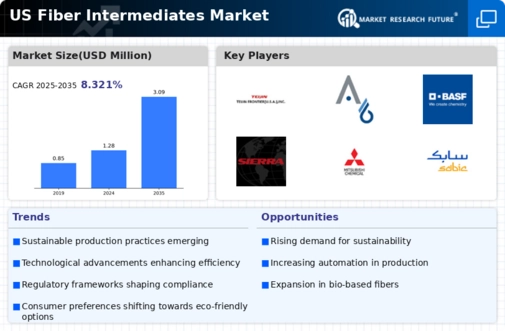The US Fiber Intermediates Market is characterized by a dynamic and evolving landscape, driven by technological advancements, varying consumer demands, and shifting economic conditions. As manufacturers seek to establish a foothold in this market, competition intensifies among key players who are focused on innovation, product diversification, and strategic collaborations. Companies continuously engage in market analysis and consumer behavior studies to fine-tune their offerings, allowing them to adapt to the rapid changes within the industry.
The entry barriers for new players are substantial, which fosters a market structure dominated by established firms, all vying for enhanced market share through value-added offerings and sustainability initiatives.Dow Chemical is a significant player within the US Fiber Intermediates Market, noted for its advanced technologies and innovative solutions that cater to a range of applications. The company boasts a comprehensive portfolio of products that include polymers, resins, and fibers, reinforcing its strong positioning in the market.
Dow Chemical is well-regarded for its deep-rooted expertise in chemical production, which enhances its operational efficiencies and allows for the rapid adaptation of its product lines. Furthermore, Dow's commitment to sustainability not only appeals to environmentally conscious consumers but also positions the company as a leader in developing eco-friendly fiber intermediates, further solidifying its competitive edge in the U.S. market. Teijin also plays a crucial role in the US Fiber Intermediates Market, focusing primarily on high-performance fibers and advanced materials.
The company's key products include aramid fibers, carbon fibers, and various thermoplastic resins that cater to diverse industrial needs, ranging from automotive to aerospace applications. Teijin's market presence is strengthened by strategic mergers and acquisitions, enabling the company to expand its technological capabilities and product offerings in the U.S. Additionally, its focus on innovation and research and development ensures that Teijin remains at the forefront of industry advancements. The embrace of sustainability is another pillar of Teijin's success, as the company integrates eco-friendly practices in its manufacturing processes, appealing to a market increasingly driven by environmental concerns.
These attributes collectively enhance Teijin's competitive position within the U.S. Fiber Intermediates Market.






















Leave a Comment